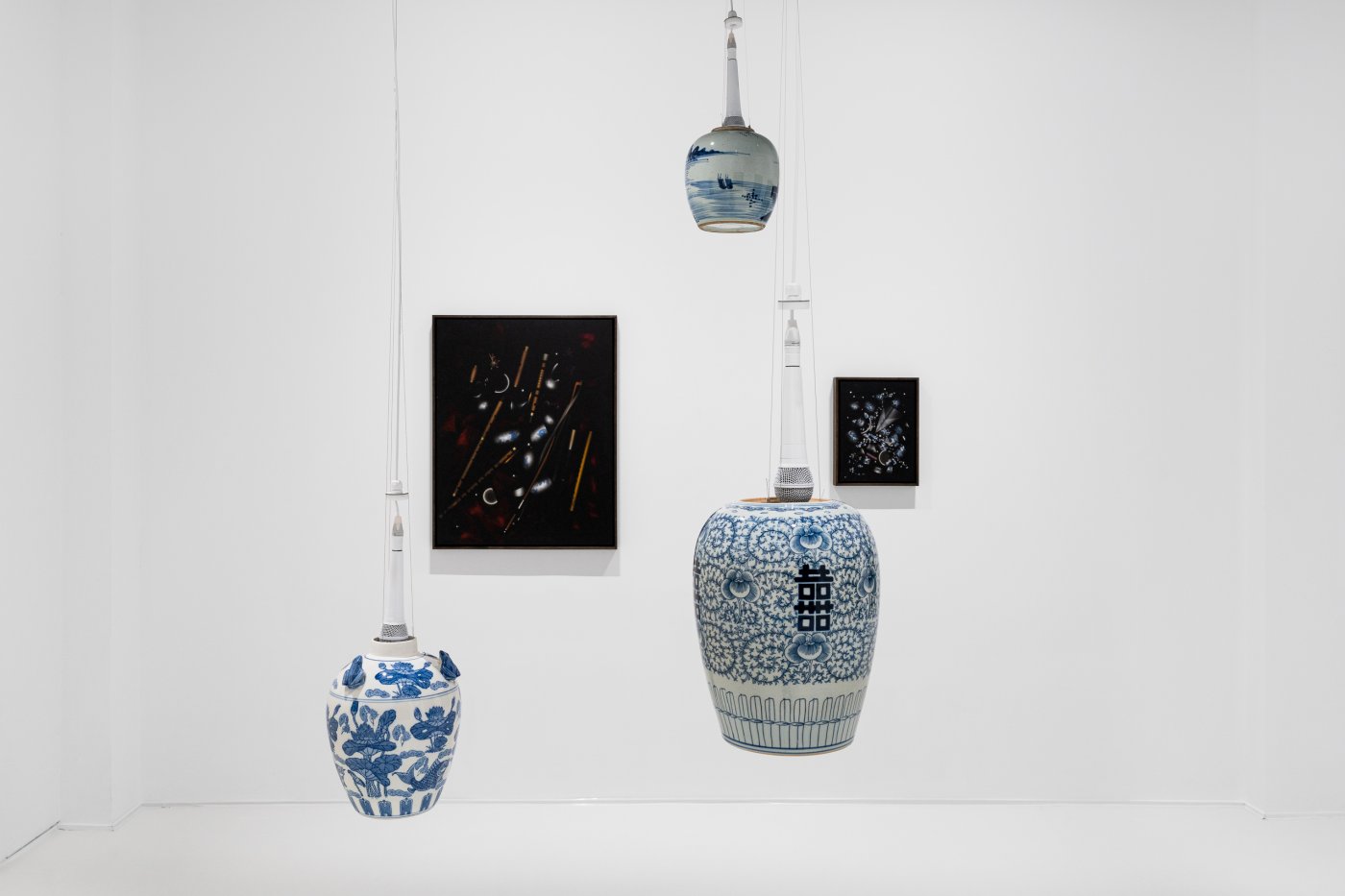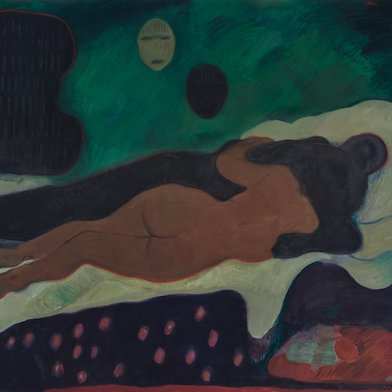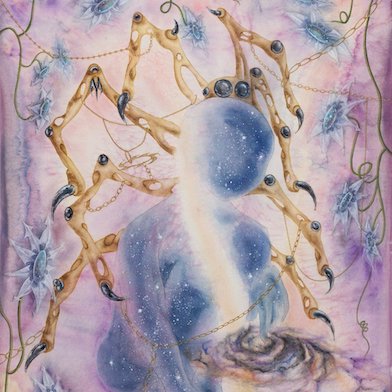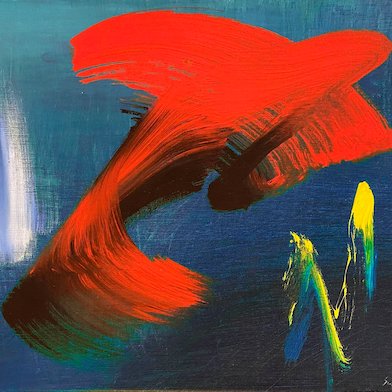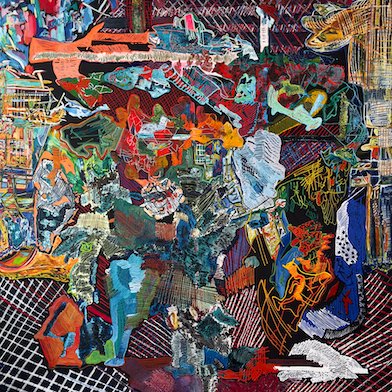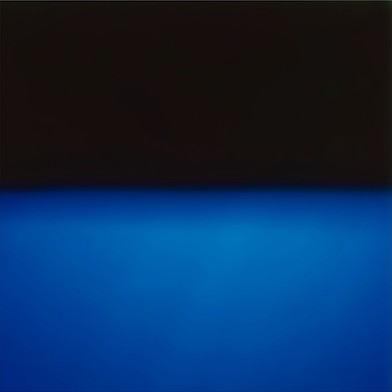
Open: Tue-Sat 11am-7pm
Visit
Oliver Beer: Recompositions: Night Revels
Almine Rech, Shanghai
Fri 12 May 2023 to Sat 24 Jun 2023
27 Huqiu Road, 2nd Floor, 200002 Oliver Beer: Recompositions: Night Revels
Tue-Sat 11am-7pm
Artist: Oliver Beer
Almine Rech Shanghai presents Oliver Beer's first solo exhibition with the gallery.
To hear what you see.
Blue-and-white porcelain vessels hang from the ceiling, with microphones amplifying each receptacle’s unique sound – this interactive sound installation is the central piece of Oliver Beer’s exhibition 'Recompositions: Night Revels' at Almine Rech Shanghai. Visitor movements activate the motion sensors, creating an immersive and ever-changing orchestra. Every unbroken vessel keeps the same note at which it resonates. Although the sound evolves every second, the harmony never changes. By manifesting the constant, Beer in turn invites us to observe what changes in the passage of time. It is as if the vessels are speaking to us, as witnesses of history, narrating the stories of their own destinies.
Pottery vessels were some of the most ubiquitous inventions across civilizations. Their production, acquisition, travel, survival, and destruction reveal to us a long history of cultural connections and highlight the universality of mankind. Among them, blue-and-white ceramics are extraordinary examples of global trade and cultural exchange, originating in China, they were later widely circulated and adopted globally through imperialism. The new work Resonance Vessels (Music of Changes) (2023) follows the lineage of Beer’s acclaimed exhibition at The Met Breuer in 2019, as well as his current presentation at Bloomberg Space in London.
Surrounding the installation are new works from the Recomposition series, all containing the same blue-and-white ceramics, but scattered into pieces. Beer’s presentation at Almine Rech Shanghai is a dramatic and ritualistic one. The contrast between “resurrection” in the middle and the environs’ “falling-apart” retells the pot-holed journey of these porcelains, and really, the shared fate of any cultural artifact. Ceramic detritus further overlapped with books, scores, and musical instruments in a seemingly haphazard way. To quote Marguerite Yourcenar: “Books are not life, only its ashes.” The same applies to artworks we see. The blending of the historical with damaged remnants of personal possessions, of the archaic with street finds, testifies to the multiplicitous world the artist, and we, inhabit today. The carefully pigmented black resin sets a theater stage-like backdrop, disclosing a dramatic scene of decay and chaos, balanced through artistic deliberation. Evolving his previous works with opaque resin, the artist mixes black ink and black pigment into transparent resin at different densities, so he can control exactly how much light hits the objects that are immersed inside. It’s like painting with light and shadow, shading and obscuring the objects to create the sense of depth, even though these pieces are only a few millimeters thick.
I couldn’t help but think of the Bapo painters, who, from the mid-19th century through the mid-20th century, faithfully depicted reproductions of antique calligraphies, rubbings, paintings, and manuscripts, alongside everyday ephemera including diaries, receipts, and letters. Facing a particularly turbulent time in history when the country was under waves of invasion and experiencing the decay of traditions, Chinese literati invented this new art form, which is radically distinct from classical Chinese landscape and figure painting, to express implicitly pressing concerns. Bapo paintings offered the literati the ground to reconcile with the new realities and situate oneself in the turmoils of history. In a similar way, Beer looks both inwardly and outwardly, resurging memories and imaginations that are private and meanwhile collective. It has been discovered that the original stelae of some torn rubbings with broken or lost characters, as depicted in Bapo paintings, were actually perfectly intact in reality. Such an act of deliberate destruction also finds resonance in Beer’s fine cutting of objects. But for Beer, it is less about destruction, and more about revelation. We are forced and tempted to look closely at these fragmented wall pieces, trying to decipher what’s underneath. One of the most extraordinary qualities of sound is that it penetrates matter. These fragmented pieces teach us to perceive the world beyond its surface.
At first, I was puzzled by the choice to freeze musical instruments in resin, rendering them completely static, as music is a form so fluid and amorphous. “However, sound is also so ephemeral. It’s fragile, fleeting, and ungraspable,” explains Beer. With the advancement of recording technologies, we can now preserve sound. But what about these broken blue-and-white porcelains? They have lost their voices. So how could we preserve lost sound? Is silence also sound? Educated both in musical composition and cinema, Beer was also trained as a visual artist. Often being discussed under the concept of synaesthesia, the artist developed creative and unique strategies to preserve them in a visualized format. The artist recalls that when he looked at the painting of The Night Banquet (1991) by the great Chinese painter Chen Yifei, itself based on the classic Chinese painting Night Revels of Han Xizai from which the exhibition draws its title, he perceived how the music of those female musicians had in some way been crystallized across the centuries. For him, blue-and-white ceramics provide an interesting point of departure in this visual endeavor; this color combination is so identifiable that we can easily relate it to art historical references. Drawing from Giovanni Bellini and Titian’s The Feast of the Gods (1514/1529), which was the first known depiction of Chinese porcelain in a Western painting, to the Dutch painter William Kalf’s Still Life with a Late Ming Ginger Jar (1669), and then John Cage’s Music of Changes (1951), Beer’s exhibition at Almine Rech Shanghai bathes us in rich material culture and multi-layered temporalities.
“Only by the form, the pattern,
Can words or music reach
The Stillness, as a Chinese jar still
Moves perpetually in his stillness.” [1]
Sound preserved visually.
— Damien Zhang, Director of Aranya Art Center
[1] T.S. Eliot, Four Quartets: Burnt Norton, Four Quartets: A Poem, Ecco; First edition (April 18, 2023)





